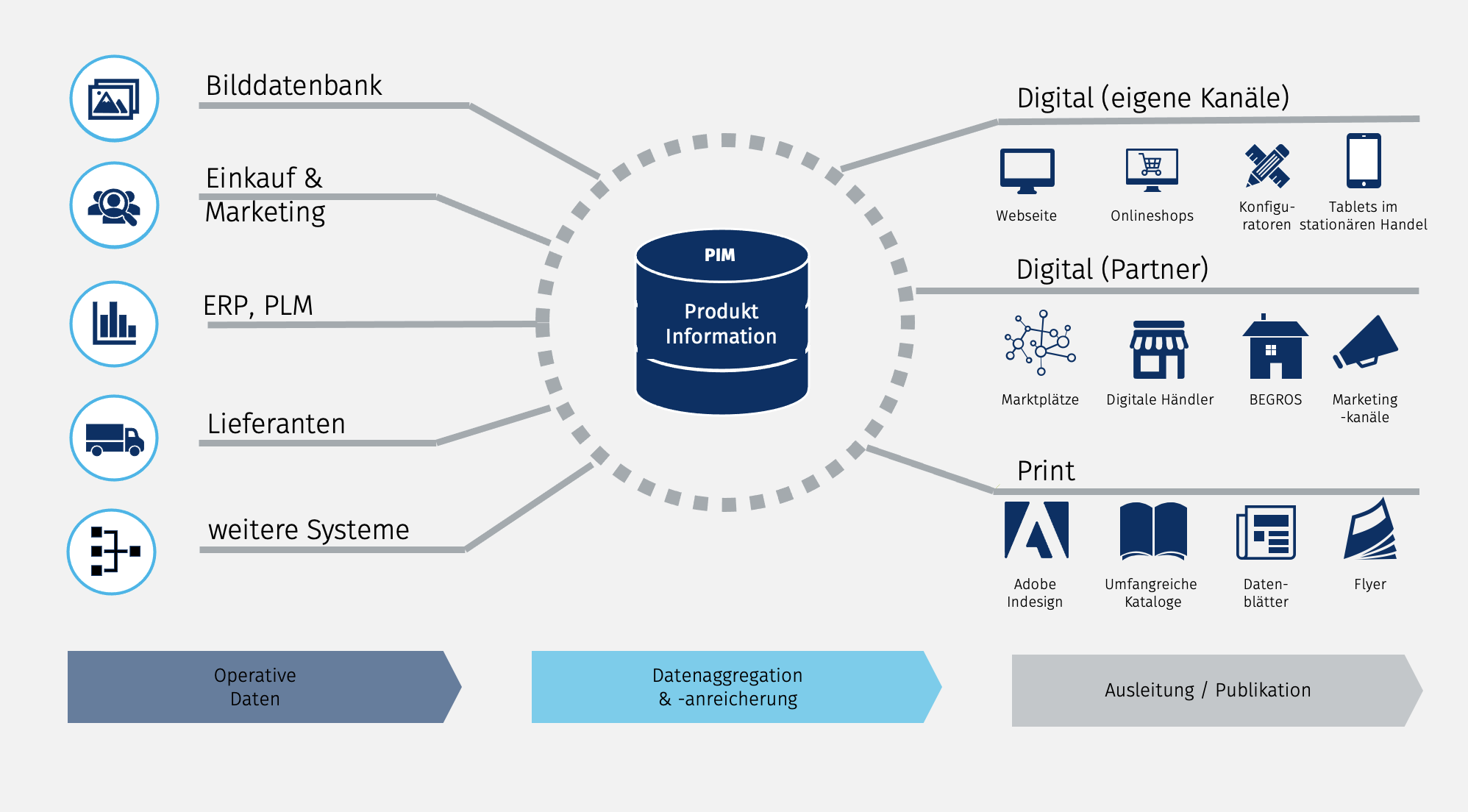Blog
Ein PIM-System (Product Information Management-System) steht an oberster Stelle, um die Time-to-Market und Conversion Rate durch hohe Datenqualität zu optimieren und Kaufabbrüche in Online-Shops zu verhindern. Hierbei ist das PIM-System nicht einfach nur ein technisches System. Es ist eine Strategie, um Produktdaten zentral und konsistent zu verwalten. Eine gute PIM-Strategie sorgt dabei für gewinnbringende Vorteile und schafft die Basis für hochwertigen Produkt-Content.
Doch wie wählen Sie das richtige und passende System für diese Strategie aus? Die Antworten auf diese Herausforderung finden Sie in einer PIM-System Evaluation – und in diesem Gastbeitrag.
Herausforderung Produktdatenverwaltung
In der Produktdatenverwaltung stehen viele Unternehmen vor den gleichen alltäglichen Herausforderungen:
- Oft befinden sich wichtige Informationen zu demselben Produkt über verschiedene Systeme verteilt. Die Folgen sind langwierige Prozesse und Datensilos.
- So geschieht die initiale Anlage eines neuen Produkts meist im Warenwirtschaftssystem eines Unternehmens, in dem neben der Preisbildung auch die Stammdatenpflege stattfindet. In Katalogtemplates werden diese Daten visuell aufbereitet und um passende Kurztexte angereichert, welche für die Print-Layouts verwendet werden. Eine Optimierung dieser Texte für Suchmaschinen bleibt dabei meistens auf der Strecke.
- Sollen dann weitere Online-Marktplätze mit glänzenden Produktdaten versorgt werden, sind meist keine fest definierten Prozesse inklusive Qualitätskontrolle etabliert, mit welchen die Daten in die entsprechenden Templates überführt werden könnten.
- Neben sämtlichen Eigenschaften gehören auch digitale Assets zu Produkten wie z. B. Montageanleitungen, Qualitätssiegel, Produktbilder und -videos, etc. In der Praxis befinden sich diese allerdings selten an der gleichen Stelle wie die Produkteigenschaften. Vielmehr sind sie auf firmeninternen Netzlaufwerken oder anderen Speichermedien zu finden, sodass eine eindeutige Zuordnung höchstens über den Dateinamen möglich ist.
Jede einzelne dieser Schwierigkeiten verlangt nach einer universellen Lösung, nach Zentralität und nach Konsistenz . Gute Neuigkeiten für alle Unternehmen, deren Kollegium sich mit solchen Problemen im Arbeitsalltag konfrontiert sieht: Ein PIM-System macht sich genau dies zur Aufgabe. Als Dreh- und Angelpunkt für Produktdaten integriert sich solch ein System in komplexe Systemlandschaften, und zwar genau in die Mitte. Also dort, wo Informationen von Lieferanten aus der Warenwirtschaft sowie aus der Produktion aggregiert und angereichert werden können, um anschließend in diverse Zielkanäle zu gelangen.

Nun aber zu der Auswahl des passenden Systems. Hierbei gilt nicht: „Je teurer, desto besser.“ Vielmehr müssen neben den exakten Anforderungen an das System auf die Produktdatenstrategie des Unternehmens abgestimmt und die folgenden Prozesse in der Wertschöpfungskette für Produktdaten angepasst werden:
- Die Erfassung von Produktdaten,
- das Anreichern und Erstellen (kanalunabhängiger) Informationen,
- die Qualitätssicherung von erzeugtem Content und
- die Distribution der fertigen Produktdatensätze.
Was bei der PIM-Auswahl zu beachten ist
Zu definieren sind der Projektscope und die Ziele der PIM-Einführung, um einen Anforderungskatalog zu erstellen. Es sollten sowohl Anforderungen, die viele Unternehmen in den meisten Fällen gemein haben dürften, als auch spezielle Anforderungen, die mit dem Datenmodell zusammenhängen oder mit der Anbindung an bestimmte Zielkanäle, abgedeckt werden.

Allgemeine Anforderungen dürften sein, dass alle Produktinformationen zentral in einem System gepflegt, verwaltet und abgerufen werden können. Eine leistungsstarke Suchfunktion ermöglicht dabei eine schnelle Auffindbarkeit aller Informationen. Übersichtlichkeit, einfache Bedienbarkeit und komfortable Massenbearbeitung sollten ebenfalls grundlegende Kriterien sein.
Auf dem PIM-Markt gibt es zahlreiche Softwareanbieter. Deshalb ist es das Ziel, möglichst schnell zu einer Shortlist zu gelangen, um Anforderungen gezielt mit Features zu vergleichen. Oft reichen hierfür schon einige wenige Kriterien wie z.B. ein Branchenfokus, die Preiskategorie und ein grober Überblick zu angebotenen Modulen, um die Longlist zu filtern. Es ist ratsam, die Systemauswahl von einem unabhängigen Beratungsdienstleister begleiten zu lassen, der entsprechende Anforderungen zu echten Use Cases und Bewertungskriterien formen kann und Softwareanbieter schnell einzuordnen weiss.
Die Anbieter auf der Shortlist können dann hinsichtlich der verfügbaren Features verglichen werden. Um Use Cases optimal abgleichen zu können, lohnt es sich Anbieter einzuladen, um sich deren Systeme vorstellen zu lassen. Die Demonstrationen der Systeme werden aussagekräftiger, wenn den Anbietern zur Vorbereitung bereits Anforderungen vorliegen. Die Bewertung kann anschliessend in einem Punkte- oder Schulnotensystem erfolgen, sodass der Best Fit für das Unternehmen numerisch dargestellt werden kann. Ein Beratungsdienstleister wird dabei nicht nur den „Gewinner“ herausstellen, sondern verschiedene Szenarien aufzeigen, in denen PIM-Systeme unterschiedlicher Hersteller einen Mehrwert bieten.
Der erste gemeinsame Schritt für eine PIM-Systemevaluation für Ihr Unternehmen könnte die Durchführung eines Scoping Workshops sein. Er dient zur weiteren Aufnahme des Ist-Zustands bezüglich der Prozesse und Systeme sowie der Abgrenzung des Projektumfelds und -inhalts. Die Ergebnisse sind massgebend für die Berücksichtigung von Erfolgsfaktoren, die über die reine Evaluation hinausgehen. hmmh berät Sie hierbei gerne zum weiteren Vorgehen.
Um das passende PIM-System auszuwählen, braucht es verschiedene Kompetenzen und Fähigkeiten. hmmh steht Ihnen mit Expert:innen zur Seite, die über das technische Know-how im Umgang mit Automatisierungsplattformen und PIM-Systemen verfügen. Darüber hinaus bieten wir Ihnen 25 Jahre fachliche Expertise in der Erstellung von suchmaschinenoptimierten und empathischen Textinhalten für Ihre Produkte, Leistungen oder Webseiten. Nur so kann die Qualität der Texte Ihre Zielgruppe überzeugen.
Wie können wir Sie unterstützen?
Möchten Sie wissen, wie ein neues PIM-System in ihrem Unternehmen eingeführt werden kann? Gerne beratet Sie zusammen unser Solution Partner hmmh AG. Wir freuen uns auf Ihre Kontaktaufnahme.
